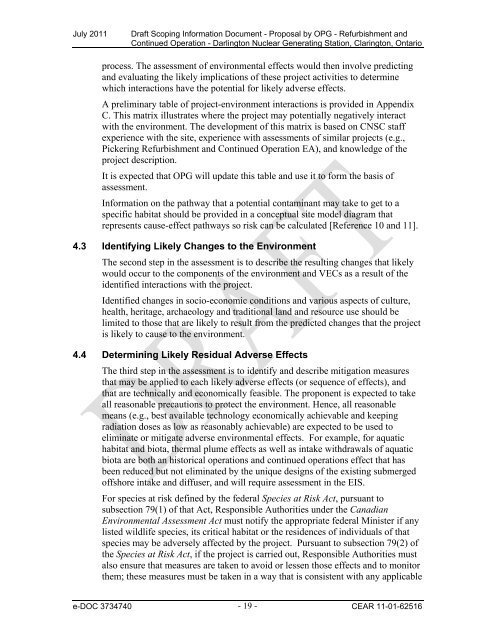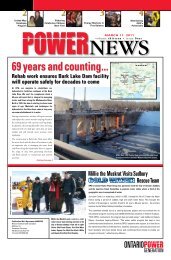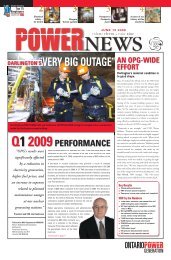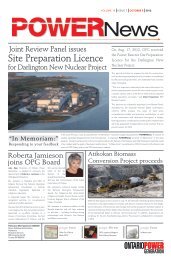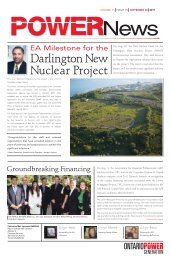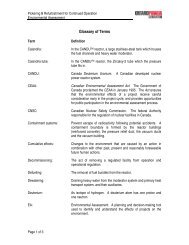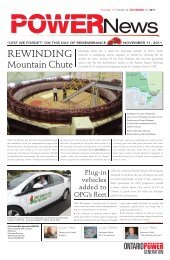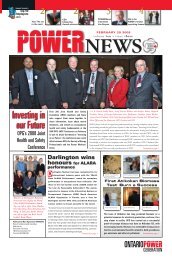Draft Scoping Information Document - Ontario Power Generation
Draft Scoping Information Document - Ontario Power Generation
Draft Scoping Information Document - Ontario Power Generation
Create successful ePaper yourself
Turn your PDF publications into a flip-book with our unique Google optimized e-Paper software.
July 2011<br />
<strong>Draft</strong> <strong>Scoping</strong> <strong>Information</strong> <strong>Document</strong> - Proposal by OPG - Refurbishment and<br />
Continued Operation - Darlington Nuclear Generating Station, Clarington, <strong>Ontario</strong><br />
process. The assessment of environmental effects would then involve predicting<br />
and evaluating the likely implications of these project activities to determine<br />
which interactions have the potential for likely adverse effects.<br />
A preliminary table of project-environment interactions is provided in Appendix<br />
C. This matrix illustrates where the project may potentially negatively interact<br />
with the environment. The development of this matrix is based on CNSC staff<br />
experience with the site, experience with assessments of similar projects (e.g.,<br />
Pickering Refurbishment and Continued Operation EA), and knowledge of the<br />
project description.<br />
It is expected that OPG will update this table and use it to form the basis of<br />
assessment.<br />
<strong>Information</strong> on the pathway that a potential contaminant may take to get to a<br />
specific habitat should be provided in a conceptual site model diagram that<br />
represents cause-effect pathways so risk can be calculated [Reference 10 and 11].<br />
4.3 Identifying Likely Changes to the Environment<br />
The second step in the assessment is to describe the resulting changes that likely<br />
would occur to the components of the environment and VECs as a result of the<br />
identified interactions with the project.<br />
Identified changes in socio-economic conditions and various aspects of culture,<br />
health, heritage, archaeology and traditional land and resource use should be<br />
limited to those that are likely to result from the predicted changes that the project<br />
is likely to cause to the environment.<br />
4.4 Determining Likely Residual Adverse Effects<br />
The third step in the assessment is to identify and describe mitigation measures<br />
that may be applied to each likely adverse effects (or sequence of effects), and<br />
that are technically and economically feasible. The proponent is expected to take<br />
all reasonable precautions to protect the environment. Hence, all reasonable<br />
means (e.g., best available technology economically achievable and keeping<br />
radiation doses as low as reasonably achievable) are expected to be used to<br />
eliminate or mitigate adverse environmental effects. For example, for aquatic<br />
habitat and biota, thermal plume effects as well as intake withdrawals of aquatic<br />
biota are both an historical operations and continued operations effect that has<br />
been reduced but not eliminated by the unique designs of the existing submerged<br />
offshore intake and diffuser, and will require assessment in the EIS.<br />
For species at risk defined by the federal Species at Risk Act, pursuant to<br />
subsection 79(1) of that Act, Responsible Authorities under the Canadian<br />
Environmental Assessment Act must notify the appropriate federal Minister if any<br />
listed wildlife species, its critical habitat or the residences of individuals of that<br />
species may be adversely affected by the project. Pursuant to subsection 79(2) of<br />
the Species at Risk Act, if the project is carried out, Responsible Authorities must<br />
also ensure that measures are taken to avoid or lessen those effects and to monitor<br />
them; these measures must be taken in a way that is consistent with any applicable<br />
e-DOC 3734740 - 19 -<br />
CEAR 11-01-62516


